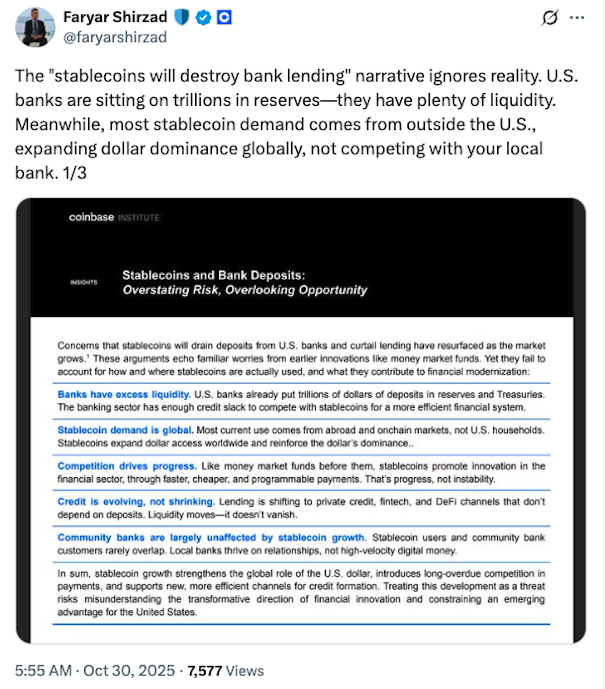Stablecoins pose minimal threat to US banks, as most demand originates from international users seeking dollar exposure rather than competing with domestic deposits. Coinbase researchers emphasize that stablecoins expand global dollar dominance without significantly impacting local banking, countering fears of customer exodus from yield-bearing stablecoins.
-
Global Demand Drives Stablecoins: Over two-thirds of transfers occur outside the US, primarily in emerging markets hedging against currency depreciation.
-
Stablecoins function as a parallel financial layer, not a direct rival to traditional bank accounts.
-
US commercial bank deposits exceed $18 trillion, with stablecoin circulation projected at $5 trillion globally, mostly foreign-held and marginal to domestic impacts (Coinbase market note).
Discover how stablecoins impact US banks without cannibalizing deposits. Learn why banking groups’ fears of yield offerings are overstated and explore global benefits in this insightful analysis. Stay ahead in crypto trends.
What is the stablecoins impact on US banks?
Stablecoins impact on US banks is often overstated, as these digital assets primarily serve international users rather than drawing funds from domestic banking customers. According to Coinbase researchers, stablecoins enhance the global reach of the US dollar without substantially competing with traditional bank deposits or lending activities. This perspective challenges narratives suggesting widespread adoption could lead to a banking customer exodus, particularly regarding yield-bearing stablecoins.
How do stablecoin yields affect banking deposits?
Yield-bearing stablecoins have sparked concerns among US banking groups, who argue to Congress that such offerings could lure deposits away from traditional accounts and undermine lending. However, Coinbase policy chief Faryar Shirzad counters that this view ignores the tokens’ real-world applications. “The ‘stablecoins will destroy bank lending’ narrative ignores reality,” Shirzad stated. Most stablecoin demand stems from outside the US, where users in emerging markets utilize them to access dollar stability amid local currency volatility. Data from blockchain analytics indicates that approximately two-thirds of stablecoin transfers occur on decentralized finance platforms or other blockchain networks, operating as a separate transactional layer parallel to the domestic banking system. This separation minimizes direct competition, with stablecoins acting more as a tool for global dollar access than a substitute for everyday US banking services. Banking groups’ push for regulatory clamps on yields overlooks these dynamics, as evidenced by historical parallels with innovations like money market funds, which initially raised similar alarms but ultimately coexisted with the banking sector.
US banking groups have urged Congress to clamp down on stablecoin yields, arguing it would trigger a US banking customer exodus. Concerns that crypto stablecoins will harm US banks by cannibalizing banking deposits are ill-placed and don’t consider the real-world uses of the tokens, according to Coinbase researchers.
“Most stablecoin demand comes from outside the US, expanding dollar dominance globally, not competing with your local bank.”
Shirzad shared a market note that said the arguments over stablecoins impact on bank deposits and lending “echo familiar worries from earlier innovations like money market funds. Yet they fail to account for how and where stablecoins are actually used.”
US banking groups have argued that stablecoins offering yield could compete with bank accounts and trigger bank outflows, and have urged Congress to clamp down on services offering yield on stablecoins.

Source: Faryar Shirzad
Stablecoin demand is global, not US-centric
Coinbase argued in its note that the most demand for stablecoins comes from “international users seeking dollar exposure” and not from US consumers. It said emerging markets use US dollar stablecoins to hedge against local currency depreciation, and the tokens are a “practical form of dollar access” for the underbanked.
The note added that around two-thirds of stablecoin transfers happen on decentralized finance or blockchain platforms. “In that sense, they are the transactional plumbing of a new financial layer that runs parallel to, but largely outside, the domestic banking system,” Coinbase said.
“Treating stablecoins as a threat misreads the moment: they strengthen the dollar’s global role and unlock competitive advantages that the US shouldn’t constrain,” Shirzad said.
Community banks won’t collapse, Coinbase claims
Coinbase argued that the concerns that community banks will be hit hard by widespread stablecoin use also lack credence, explaining that the typical stablecoin user “is not the same as the typical community bank customer.”
“Community banks and stablecoin holders barely overlap,” Shirzad said, adding that banks “could improve their services with stablecoins.”
Western Union picks Solana for its stablecoin and crypto network.
Coinbase also said forecasts of trillions of dollars flowing into stablecoins over the next 10 years “should be carefully scrutinized.”
“Even if stablecoin circulation reached $5 trillion globally, a majority of that value would still be foreign-held or locked in digital settlement systems, not diverted from US checking or savings accounts,” it said.
Coinbase noted that commercial bank deposits in the US exceed $18 trillion and claimed that the impact of stablecoin on deposits would “remain marginal, while the global influence of the US dollar would significantly increase.”
Multiple big banks and major financial institutions have launched stablecoin services or are exploring offers after the US passed the GENIUS Act earlier this year, which regulates how stablecoin service providers operate in the country.
Magazine: Bitcoin is ‘funny internet money’ during a crisis: Tezos co-founder
Frequently Asked Questions
Will stablecoin yields cause a mass exodus from US bank accounts?
No, stablecoin yields are unlikely to cause significant outflows from US bank accounts, as primary demand originates from international markets. Coinbase data shows that even at $5 trillion in global circulation, most funds remain outside domestic banking, preserving the stability of US deposits exceeding $18 trillion.
How are stablecoins used in emerging markets?
In emerging markets, stablecoins provide reliable access to the US dollar, helping users protect savings from local inflation and depreciation. They serve as an essential tool for the underbanked, facilitating cross-border transactions on blockchain platforms without relying on traditional financial infrastructure.
Key Takeaways
- Global Focus of Stablecoins: Demand is predominantly international, bolstering US dollar hegemony rather than eroding domestic bank deposits.
- Parallel Financial System: Stablecoins operate in a distinct layer via DeFi and blockchains, minimizing overlap with community banking customers.
- Regulatory Balance: Policymakers should view stablecoins as an opportunity to enhance competitiveness, integrating them thoughtfully without overly restrictive measures on yields.
Conclusion
The debate surrounding stablecoins impact on US banks highlights a tension between innovation and caution, with banking groups advocating for curbs on stablecoin yields to prevent deposit flight. Yet, insights from Coinbase researchers and policy chief Faryar Shirzad underscore that these tokens primarily drive global dollar adoption, offering underbanked populations in emerging markets a vital hedge against economic instability. As the US navigates the GENIUS Act’s framework for stablecoin regulation, embracing their role could amplify economic advantages. Financial institutions are encouraged to explore stablecoin integrations to modernize services and stay competitive in an evolving landscape.
